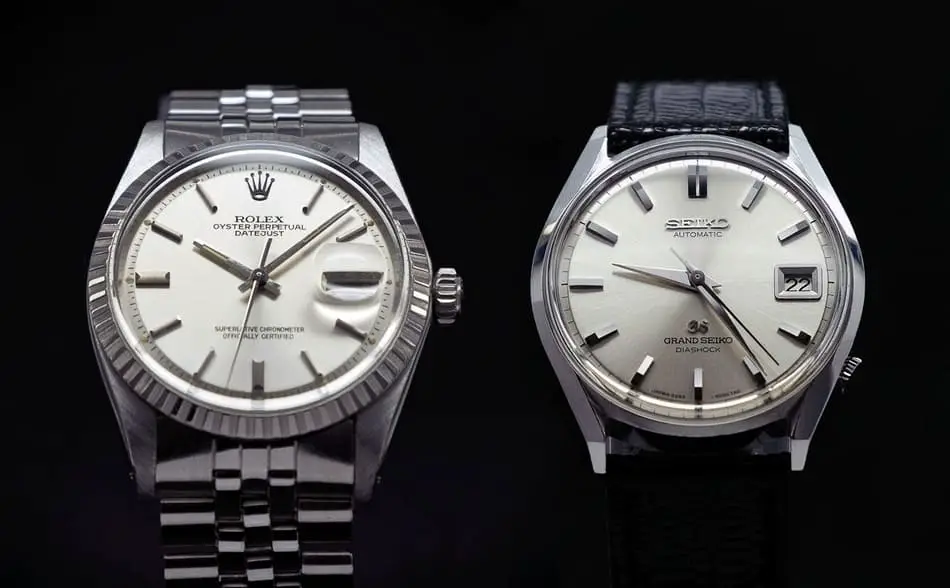
A controversy that has spanned decades and is still going strong. However, defining which is better is quite objective and difficult to conclude. Each has its own merit and uniqueness to the craft of its watches. Hence, to make a generic blanket statement on which is better is almost irresponsible.
Here’s why Japan watches are better than Swiss
Even though Swiss are known to be the pioneers of watchmaking, quality and reliability seem to be on a downward slope for some of the top Swiss brands. On the other hand, the Japanese are always innovating and improving their craft.
Below are some of the reasons which I think makes Japan watches triumph Swiss watches:
Quality-Control
When we look at a higher level – In terms of quality control, Japan watches do have the upper hand. Almost 100% of its components are made in-house, even the grease, lubricating oils and luminous paint are made in-house. This gives them total control of their product when it comes to uniformity and quality. One of my favorite quotes from a Japan watch brand.
Made by hand for those who value perfection.
Grand Seiko, Japan
On the other hand, Swiss watches do not make all their components in-house – Components are mostly sourced and made from China and Thailand.
That does not mean that the Swiss watches have their quality compromised. In fact, from my last visit to the Rolex watch lab in Genève, the quality control is so stringent that it rejects up to 70% of the watches before going into production.
Bang for the Buck
In terms of monetary value, people tend to believe that Swiss watches are more expensive and prestigious. Whereas Japan is known to produce low-cost but high-quality and reliable watches.
The truth is that Japan has already moved to high-end and master watchmaking, crafting the best contemporary watches that are worth every penny. A well-known line for this would be the Grand Seiko from Japan.

Japan, being the pioneer of the modern quartz movement since 1969 where they first launched the Seiko Astron became phenomenal in the watch industry. After this, many other companies, including the Swiss started to play catch up and adopted the technology for their own production.
A good way to know which watch is more worth it is when we compare a Japan watch with a Swiss watch at the same price point and complications available.
Grand Seiko – SBGJ019 ($7,300)

Powered by a 9S86 Hi-Beat movement that beats at 36,000 BPH
Gorgeous textured dial with a mixture of brushed and polished accents.
Rolex DATEJUST- 1603 ($7,300)

Powered by 1570 movement that beats at 19,800 BPH.
Clean and classic look, known to be one of the easiest Rolex movements to service and maintain.
What is BPH in watches? BPH refers to ‘Beats per Hour’ on the second hand of the watch. The lowest BPH a watch can go is 3600 BPH, which also means 60 beats per minute and that is 1 beat per second. Having a higher BPH means that the sweeping motion of the second hand is smoother and it is able to keep more accurate time.
Of course, there are other factors that are to consider, this comparison is simply touching on the bare surface of the dome.
What does Japan Movement on a Watch mean?
To get obvious out of the way, a Japan movement watch is made in Japan. While a Swiss movement watch is made in Switzerland.
So, what does Japan movement in a watch mean? A watch movement is considered a Japan movement if the watch is assembled, manufactured and inspected in Japan. A Japan movement is known to be incredibly reliable and a timepiece that will hold its value well.
A Japan movement in a watch acts as the engine to ensure that the functions in the watch work properly. It is the internal mechanism inside the watch that moves the hands of the watch and powers any complications such as the calendar or chronograph.
Japan, known for its perfectionism is not too far away from having the best quality watches in the world. Maintaining the highest standards of crafting the best watch movement has always been a pride and priority in Japan’s watchmaking culture.
In fact, the Japanese have put so much emphasis on the quality of their watches that they have all the components of a watch created by themselves. This even
Having all the components created in-house gives the Japanese total control of the quality over the watches they build and also gives uniformity in terms of quality across their production.
To summarise, a Japan movement on a watch is simply prided on the highest quality possible, where all components in the watch are designed and built in-house by the watchmakers. The reliability of the Japan movements is incomparable.
What does Swiss Movement on a Watch mean?
On the same page, a Swiss movement watch is made in Switzerland.
So, what does Swiss movement on a watch mean? A watch movement is considered Swiss movement if the movement of the watch is being assembled and inspected in Switzerland. In addition, the amount of the total value of the watch needs to be at least 50 percent and above (excluding the assembly cost).
Switzerland, known for its long heritage of watchmaking and ingenuity craftsmanship in creating watch movements has always been a leader in the watch industry.
Contrastingly, the Swiss movement, although made in Switzerland, does not have its components built in-house. In fact, more than half of its components are sourced and made in China or Thailand.
Does that mean Swiss movements aren’t 100% Swiss made? Well, that is true but for most people that isn’t really a big deal. Because the quality of Swiss watches isn’t compromised due to its stringent quality-control, with over 70% of the watches being rejected before pushing into the production line.
Besides having their components outsourced, the Swiss movements may not be the most technological advance as compared to the Japan movements. A popular Swiss watch brand, Tag Heuer has recently admitted to buying movement components from Seiko. And there are many ‘Swiss’ watches that actually uses Japan movements (Miyota movement).
To summarise, a Swiss movement on a watch is not 100% built in-house. Components are sourced and made from China, Thailand and even Japan. However, quality is not compromised due to its stringent quality-control where over 70% of its watches are rejected before going into production.
Japan or Swiss Watch?
In my opinion, you shouldn’t dwell too much where the watch was made but rather who made it.
Choosing brands that are reputable and established is a good way to gauge. Swiss watchmakers such as Rolex, Omega and Patek Philippe have their components mostly built in-house as compared to other Swiss brands
The same goes for Japan watches too, going for brands that are established is a good approach, Japan watchmakers such as Seiko and Citizen are my personal favorites.
Especially Seikos, you can never go wrong with this brand regardless of any price point you are getting your watch at. The classic and elegance infused into their watchmaking are simply brilliant and impeccable.